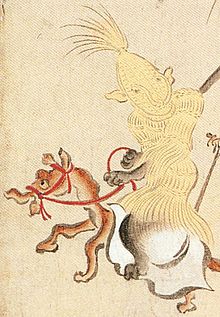Bakezōri: Difference between revisions
No edit summary |
|||
| (23 intermediate revisions by 19 users not shown) | |||
| Line 1: | Line 1: | ||
{{short description|Japanese folklore}} |
|||
{{Refimprove|date=November 2011}} |
|||
[[File:Hyakki Yako Emaki Sandal Spirit.jpg|thumb|Depiction of a sandal-Yōkai in ''Hyakki Yagyō [[Emaki]]'' of the [[Muromachi period]].]] |
|||
{{nihongo|'''Bakezōri'''|化け草履}} is a creature from [[Japanese folklore]]. It is a straw ''[[zori|zōri]]'' sandal{{citation needed}} which has been transformed into a ''[[tsukumogami]]'', a ''[[yōkai]]'' (spirit creature) {{citation needed}} which was once an ordinary household item. It runs through the house and chants "''kararin, kororin, kankororin!''"{{citation needed}} |
|||
A {{Nihongo|'''Bakezōri'''|化け草履||literally meaning "ghost-sandal"|lead=yes}} is a fictitious being from Japanese [[folklore]] belonging to the group of [[Yōkai]]. |
|||
== Description == |
|||
:In a house where footwear is treated improperly, this old zōri sandal comes to life at night and emerges from the storeroom where it has been discarded. As it runs through the house, it can be heard chanting, "kararin, kororin, kankororin! Eyes three, Eyes three and teeth two!" Perhaps it says this in honor of its kin the [[Geta (footwear)|geta sandal]], which does indeed make such sounds and does have three eyes (the holes drilled for its straps) and two teeth (the wooden platforms on its base).{{citation needed}} |
|||
The Bakezōri is described as a wandering [[sandal]] with two arms and two legs, but only one eye. He is said to spook inhabited households during the night, running around and continuously chanting: "Kararin, kororin, kankororin, managu mittsu ni ha ninmai!" ({{lang|ja|カラリン、コロリン、カンコロリン、まなぐ三つに歯二ん枚}}; "Kararin, kororin, kankororin! They have three eyes and two teeth!"). Most possibly he's mocking his "more noble cousins", the famous [[Geta (footwear)|Geta]].<ref name=MTB>Masaharu Takemura: {{lang|ja|ろくろ首考:妖怪の生物学}}. Bungei-sha, Tokyo 2002, {{ISBN|4835546350}}, p. 89-91.</ref><ref name=MHM>Michaela Haustein: ''Mythologien der Welt: Japan, Ainu, Korea''. ePubli, Berlin 2011, {{ISBN|3844214070}}, p. 9.</ref> |
|||
== |
== Background == |
||
Design model of the Bakezōri may have been ''[[Zōri]]'', traditional sandals made of braided rice straw.<ref name=MTB/><ref name=MHM/> |
|||
* [http://www.obakemono.com/obake/bakezori/ Bakezōri entry at obakemono.com] |
|||
The being ''Bakezōri'' belongs to a special group of Yōkai, called ''[[Tsukumogami]]'' ({{lang|ja|付喪神}}; "artifact-demons"): According to Japanese folklore, households are like repair tools, kitchen appliances and even clothes of any kind which eventually come to life and receive their own consciousness when ignored or neglected for a long time (mostly after 100 years). Bakezōri are said to be normally harmless to humans, but they can start to rip or pester them. Their motivation is boredom and frustration, or simply revenge and jealousy. Most Bakezōri group up with other animated household stuff or clothes, or they simply leave home and run away.<ref name=MTB/><ref name=MHM/> |
|||
[[Category:Japanese legendary creatures]] |
|||
== Sources == |
|||
{{japan-myth-stub}} |
|||
<references/> |
|||
== External links == |
|||
[[ja:化け草履]] |
|||
* [http://yokai.com/bakezouri/ Short info about ''Bake-zori'' at ''yokai.com''] (Japanese) |
|||
[[pt:Anexo:Lista de artigos mínimos de Youkais#Bake-zori]] |
|||
{{DEFAULTSORT:Bakezori}} |
|||
[[Category:Tsukumogami]] |
|||
Revision as of 22:32, 31 March 2023

A Bakezōri (Japanese: 化け草履, literally meaning "ghost-sandal") is a fictitious being from Japanese folklore belonging to the group of Yōkai.
Description
The Bakezōri is described as a wandering sandal with two arms and two legs, but only one eye. He is said to spook inhabited households during the night, running around and continuously chanting: "Kararin, kororin, kankororin, managu mittsu ni ha ninmai!" (カラリン、コロリン、カンコロリン、まなぐ三つに歯二ん枚; "Kararin, kororin, kankororin! They have three eyes and two teeth!"). Most possibly he's mocking his "more noble cousins", the famous Geta.[1][2]
Background
Design model of the Bakezōri may have been Zōri, traditional sandals made of braided rice straw.[1][2]
The being Bakezōri belongs to a special group of Yōkai, called Tsukumogami (付喪神; "artifact-demons"): According to Japanese folklore, households are like repair tools, kitchen appliances and even clothes of any kind which eventually come to life and receive their own consciousness when ignored or neglected for a long time (mostly after 100 years). Bakezōri are said to be normally harmless to humans, but they can start to rip or pester them. Their motivation is boredom and frustration, or simply revenge and jealousy. Most Bakezōri group up with other animated household stuff or clothes, or they simply leave home and run away.[1][2]
Sources
- ^ a b c Masaharu Takemura: ろくろ首考:妖怪の生物学. Bungei-sha, Tokyo 2002, ISBN 4835546350, p. 89-91.
- ^ a b c Michaela Haustein: Mythologien der Welt: Japan, Ainu, Korea. ePubli, Berlin 2011, ISBN 3844214070, p. 9.
External links
- Short info about Bake-zori at yokai.com (Japanese)
